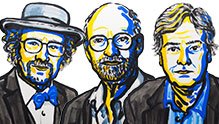Medical novel to which the molecular mechanism of circadian rhythm has been clarified

Through the circadian rhythm, living beings adapt to the rotation of the Earth. The award ceremony presented the XVIII. It has been known since the 20th century. At that time, astronomer Jean Jacques d'Ortous of Mairan discovered that the leaves of the tongue opened and closed depending on sunlight.
Later, other researchers have shown that human and animal cells also have circadian rhythm. It is responsible for controlling changes in behavior, hormones, sleep, body temperature and metabolism throughout the day.
One-piece machinery
In the 1970s, in studies with fruit flies, Seymour Benzer and Ronald Konopka discovered that mutations in a gene altered the circadian rhythm of flies, but did not know how. Period was called the gene.
They continued to investigate and, in 1984, Jeffrey C. Hall, Michael Rosbash and Michael W. American researchers Young managed to isolate the period gene. Later, Hall and Rosbash discovered the protein encoding this gene, the PER, and saw that it accumulated during the day and was destroyed at night.
How was the period gene turned on and off? This was clarified by Michael Young in 1994. Young discovered another gene involved in the control of the circadian rhythm: timeless. The protein encoding this gene, TIM, binds to the PER protein, which together penetrate the cell nucleus and block the period gene.
The next question was how the frequency of rotation was controlled. So did Young. He found another doubletime gene. The coding protein, DBT, delays the accumulation of PER protein. This allows the pace to be around 24 hours.
The Karolinska Institute stressed the importance of these research in the welfare of people as the basis of a broad field. In fact, they have shown that when life and circadian rhythm do not coincide chronically, the risk of diseases such as cancer, neurodegenerative diseases, metabolic alterations and inflammation increases. On the other hand, the adaptation of pharmacological treatments to the circadian rhythm is being investigated to make them more effective.
Buletina
Bidali zure helbide elektronikoa eta jaso asteroko buletina zure sarrera-ontzian











